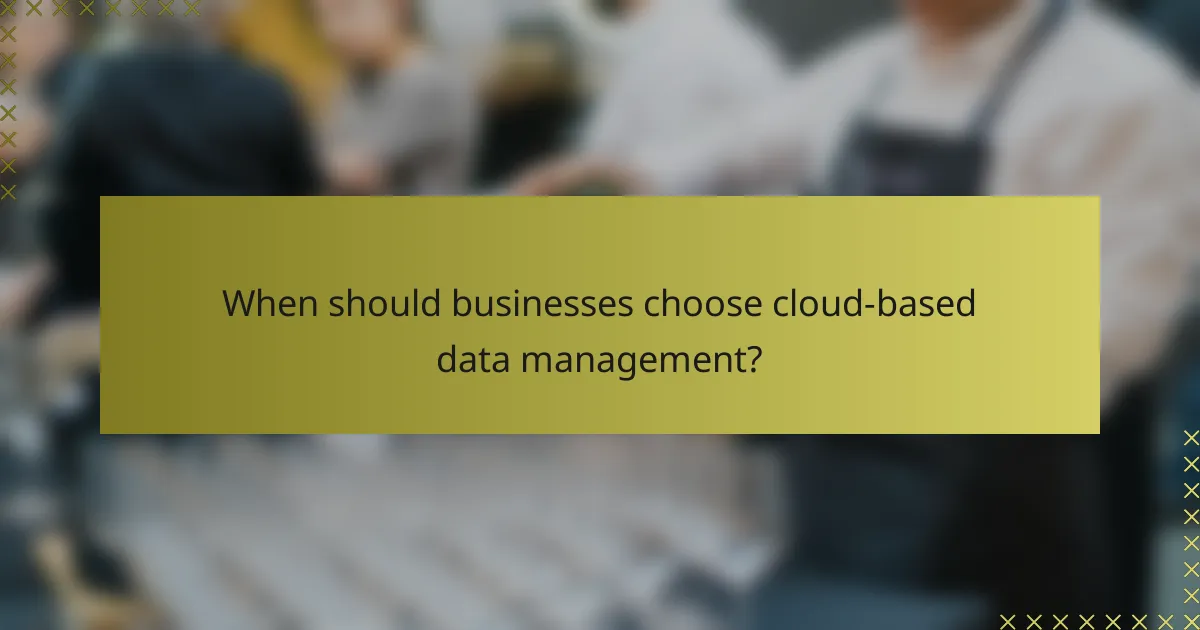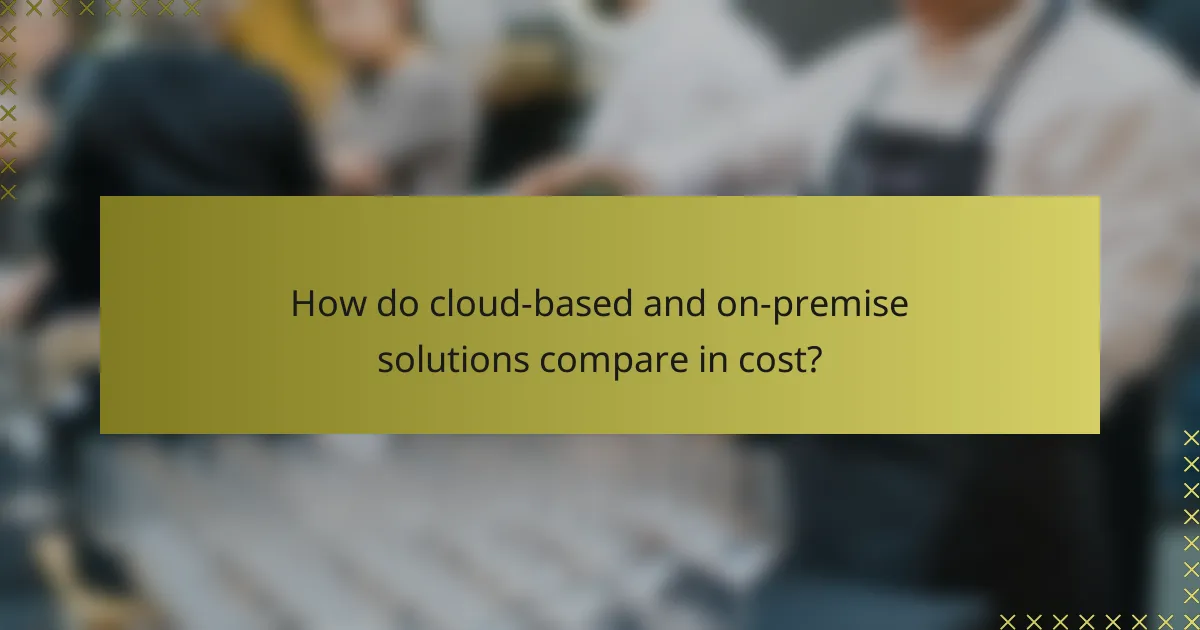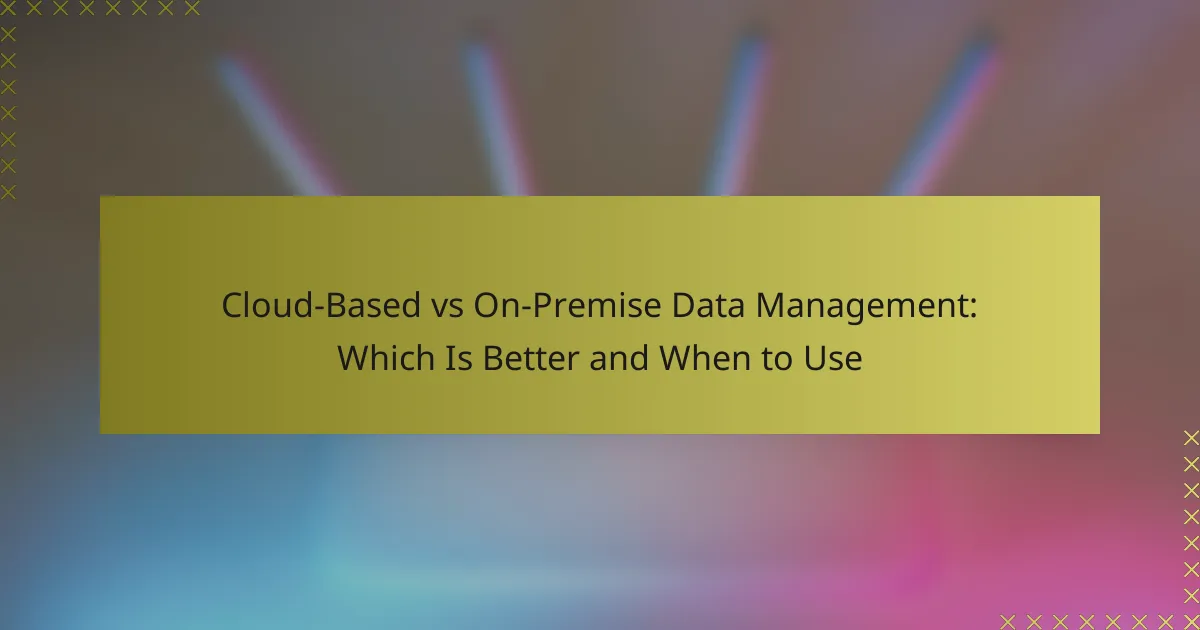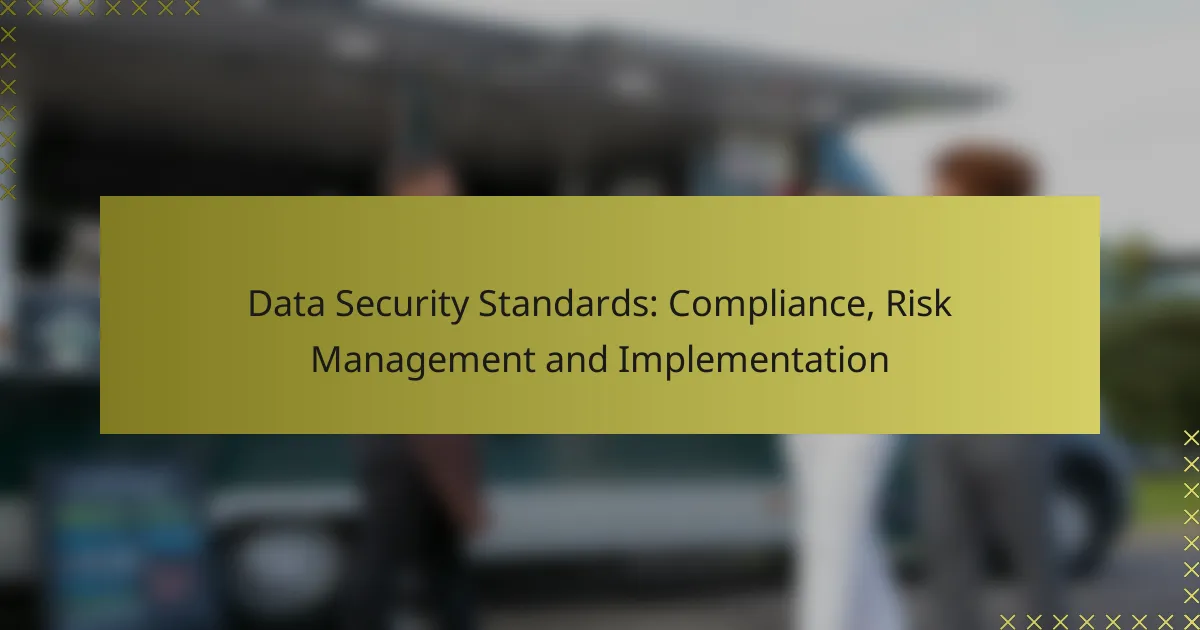In the evolving landscape of data management, organizations face the critical decision between cloud-based and on-premise solutions. Cloud-based options provide scalability, cost savings, and accessibility, making them ideal for businesses with fluctuating data needs. Conversely, on-premise systems offer enhanced security and customization, appealing to those who prioritize control and regulatory compliance. Understanding the specific requirements of your organization is essential in choosing the right approach for effective data management.

What are the advantages of cloud-based data management?
Cloud-based data management offers several advantages, including enhanced scalability, cost savings, and improved accessibility. Organizations can leverage these benefits to optimize their data handling processes and support remote work environments.
Scalability and flexibility
Cloud-based data management systems provide significant scalability, allowing businesses to easily adjust their storage and processing capabilities based on demand. This flexibility means that companies can quickly scale up during peak periods without the need for substantial upfront investments in hardware.
For example, a retail business can increase its data storage during holiday seasons and reduce it afterward, ensuring they only pay for what they use. This adaptability is particularly beneficial for startups and small businesses that may experience fluctuating data needs.
Cost-effectiveness
Using cloud-based solutions can be more cost-effective compared to on-premise systems. Organizations typically avoid hefty initial capital expenditures on hardware and software, opting instead for a subscription-based model that spreads costs over time.
Additionally, cloud services often come with lower maintenance costs, as the provider handles updates and infrastructure management. This can lead to savings of tens of percent compared to traditional setups, especially for small to medium-sized enterprises.
Automatic updates and maintenance
Cloud-based data management systems usually include automatic updates and maintenance, ensuring that users always have access to the latest features and security enhancements. This reduces the burden on internal IT teams, allowing them to focus on strategic initiatives rather than routine upkeep.
For instance, a cloud provider may roll out new functionalities or security patches without any downtime, which is a significant advantage over on-premise systems that require scheduled maintenance windows.
Remote access and collaboration
One of the key benefits of cloud-based data management is the ability to access data from anywhere with an internet connection. This remote access facilitates collaboration among teams, regardless of their physical location.
For example, employees working from different offices or home environments can easily share files and work on projects in real-time. This capability not only enhances productivity but also supports a more flexible work culture, which is increasingly important in today’s business landscape.

What are the advantages of on-premise data management?
On-premise data management offers several advantages, particularly in terms of security, customization, and regulatory compliance. Organizations that prioritize control over their data often find on-premise solutions more suitable for their needs.
Enhanced security and control
On-premise data management allows organizations to maintain complete control over their data security. By hosting data on local servers, businesses can implement tailored security measures that align with their specific requirements and risk profiles.
This control can lead to enhanced protection against data breaches and unauthorized access, as sensitive information remains within the organization’s physical premises. Companies can also respond more swiftly to security incidents, minimizing potential damage.
Customization options
On-premise solutions provide extensive customization options that cater to unique business needs. Organizations can tailor their data management systems to fit specific workflows, integrate with existing software, and modify functionalities as required.
This level of customization is often limited in cloud-based solutions, where users must adapt to the provider’s framework. On-premise systems can evolve alongside the organization, ensuring that data management remains aligned with business goals.
Compliance with regulations
For organizations in regulated industries, on-premise data management can simplify compliance with laws and standards. By keeping data in-house, businesses can ensure that they meet specific regulatory requirements, such as data residency and privacy laws.
This is particularly relevant for sectors like finance and healthcare, where strict regulations govern data handling. On-premise solutions can facilitate audits and reporting, making it easier to demonstrate compliance to regulatory bodies.

When should businesses choose cloud-based data management?
Businesses should consider cloud-based data management when they require flexibility, scalability, and cost-effectiveness. This approach is particularly beneficial for organizations that anticipate growth or have variable data demands, as it allows for easy adjustments without significant upfront investment in hardware.
Startups and small businesses
Startups and small businesses often face budget constraints and limited IT resources. Cloud-based data management provides an affordable solution, allowing these companies to access advanced technology without the need for expensive infrastructure. Many cloud providers offer pay-as-you-go pricing, which helps manage cash flow effectively.
Additionally, cloud services can scale with the business, accommodating growth without the need for significant capital expenditures. This flexibility is crucial for startups that may experience rapid changes in data needs.
Projects with fluctuating data needs
For projects that experience varying data requirements, cloud-based data management offers a dynamic solution. Businesses can easily adjust their storage and processing capabilities based on current demands, avoiding the costs associated with maintaining excess capacity. This is particularly useful for seasonal businesses or those with project-based work.
Using cloud services, organizations can quickly provision additional resources during peak times and scale back when demand decreases, ensuring they only pay for what they use. This adaptability can lead to significant cost savings over time.
Remote work environments
In remote work environments, cloud-based data management is essential for collaboration and accessibility. Employees can access data from anywhere with an internet connection, facilitating teamwork and productivity regardless of location. This is increasingly important as more companies adopt hybrid work models.
Moreover, cloud solutions often include built-in security features and compliance measures, helping businesses protect sensitive information while enabling remote access. Organizations should ensure they choose providers that comply with relevant regulations, such as GDPR or HIPAA, to safeguard their data effectively.

When should businesses choose on-premise data management?
Businesses should consider on-premise data management when they require complete control over their data infrastructure, especially in environments with strict compliance or security needs. This approach allows for tailored solutions that meet specific organizational requirements, often at the cost of higher upfront investments and maintenance responsibilities.
Industries with strict compliance requirements
Industries such as finance, healthcare, and government often face stringent regulatory standards that dictate how data must be stored and managed. On-premise solutions allow these organizations to implement specific security measures and access controls that comply with regulations like HIPAA or GDPR.
For example, a healthcare provider may need to ensure that patient records are stored locally to meet HIPAA requirements, which can be more easily managed with an on-premise system. This setup also facilitates regular audits and compliance checks, providing peace of mind to stakeholders.
Organizations with sensitive data
Organizations that handle highly sensitive information, such as intellectual property or personal identifiable information (PII), often prefer on-premise data management for enhanced security. By keeping data in-house, these organizations can minimize the risk of data breaches associated with cloud storage.
For instance, a law firm managing confidential client information might opt for an on-premise solution to maintain strict control over access and data handling procedures. This approach can also help in implementing custom encryption methods tailored to their specific needs.
Long-term data storage needs
For businesses with long-term data storage requirements, on-premise solutions can provide cost-effective options over time. While initial setup costs may be higher, ongoing expenses can be lower compared to cloud services that charge based on storage volume and access frequency.
Companies in industries like manufacturing or research may accumulate large volumes of data that need to be retained for years. An on-premise system allows them to manage this data efficiently without incurring recurring cloud fees, making it a practical choice for long-term data retention strategies.

How do cloud-based and on-premise solutions compare in cost?
Cloud-based solutions typically offer lower initial costs compared to on-premise systems, but ongoing expenses can vary significantly based on usage and service levels. Understanding the cost structures of both options is crucial for making an informed decision that aligns with your organization’s budget and needs.
Initial setup costs
Initial setup costs for cloud-based solutions are generally lower since they do not require extensive hardware purchases or infrastructure investments. Users often pay a subscription fee that includes setup and configuration, which can range from a few hundred to a few thousand dollars depending on the service provider and features selected.
In contrast, on-premise solutions involve higher upfront costs due to the need for purchasing servers, software licenses, and possibly hiring IT staff for installation. These costs can reach tens of thousands of dollars, depending on the scale and complexity of the deployment.
Ongoing operational costs
Ongoing operational costs for cloud-based solutions usually consist of monthly or annual subscription fees, which can vary based on usage and additional features. These costs can be predictable, making budgeting easier, but they may increase if your data storage or user base grows significantly.
On-premise solutions incur costs related to hardware maintenance, software updates, and IT personnel. These expenses can fluctuate and may lead to unexpected financial burdens, especially if hardware needs replacement or if security updates are required to comply with regulations.
Hidden costs and fees
Cloud-based services may have hidden costs such as data transfer fees, additional charges for exceeding storage limits, or costs associated with premium support services. It’s important to read the fine print and understand all potential fees to avoid surprises.
On-premise solutions can also have hidden costs, including power consumption, cooling requirements, and the costs of downtime during maintenance or upgrades. Organizations should factor in these potential expenses when evaluating the total cost of ownership for on-premise systems.

What are the key factors to consider when choosing between cloud and on-premise?
When deciding between cloud-based and on-premise data management, consider factors such as data security, budget constraints, scalability, and compliance requirements. Each option has distinct advantages and trade-offs that can significantly impact your organization’s operations and costs.
Data security requirements
Data security is a critical factor in choosing between cloud and on-premise solutions. On-premise systems offer greater control over data, allowing organizations to implement tailored security measures. However, cloud providers typically invest heavily in advanced security technologies and compliance certifications, which can be beneficial for businesses lacking in-house expertise.
Evaluate your organization’s specific security needs, including regulatory requirements such as GDPR or HIPAA. If your data is highly sensitive, an on-premise solution may be preferable; otherwise, a reputable cloud provider can offer robust security features at a lower cost.
Budget constraints
Budget is a significant consideration when selecting between cloud and on-premise data management. On-premise solutions often require substantial upfront investments in hardware, software, and ongoing maintenance. In contrast, cloud services typically operate on a subscription model, allowing for predictable monthly costs and reduced initial expenditure.
Analyze your budget and cash flow to determine which option aligns better with your financial situation. If you have limited capital, cloud solutions may be more feasible, while organizations with the resources for a one-time investment might benefit from the long-term savings of on-premise systems.



